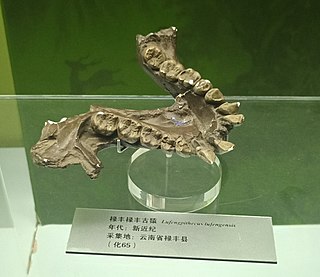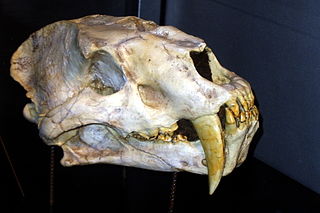
Pseudaelurus is a prehistoric cat that lived in Europe, Asia and North America in the Miocene between approximately twenty and eight million years ago. It is considered to be a paraphyletic grade ancestral to living felines and pantherines as well as the extinct machairodonts (saber-tooths), and is a successor to Proailurus. It originated from Eurasia and was the first cat to reach North America, when it entered the continent at about 18.5 Ma ending a 'cat-gap' of 7 million years. The slender proportions of the animal, together with its short, viverrid-like legs, suggest that it may have been an agile climber of trees.

Machairodus is a genus of large machairodont or ''saber-toothed cat'' that lived in Africa, Eurasia and North America during the late Miocene. It is the animal from which the subfamily Machairodontinae gets its name and has since become a wastebasket taxon over the years as many genera of sabertooth cat have been and are still occasionally lumped into it.

A mastodon is a member of the genus Mammut, which strictly defined, was endemic to North America and lived from the late Miocene to the early Holocene. Mastodons belong to the order Proboscidea, the same order as elephants and mammoths. Mammut is the type genus of the extinct family Mammutidae, which diverged from the ancestors of modern elephants at least 25 million years ago, during the Oligocene.

Ailuropodinae is a subfamily of Ursidae that contains only one extant species, the giant panda of China. The fossil record of this group has shown that various species of pandas were more widespread across the Holarctic, with species found in places such as Europe, much of Asia and even North America. The earliest pandas were not unlike other modern bear species in that they had an omnivorous diet but by around 2.4 million years ago, pandas have evolved to be more herbivorous.

Amphicyon is an extinct genus of large carnivorans belonging to the family Amphicyonidae, subfamily Amphicyoninae, from the Miocene epoch. Members of this family received their vernacular name for possessing bear-like and dog-like features. They ranged over North America, Europe, Asia, and Africa.

Agriotherium is an extinct genus of bears whose fossils are found in Miocene through Pleistocene-aged strata of North America, Eurasia, and Africa. This long-lived genus persisted from at least ~11.6–2.5 Mya. Materials from the late-surviving A. africanum in Africa have suggested that A. africanum died out during the early Gelasian.

Hemicyon, also known as the "dog-bear", is an extinct genus of hemicyonine bear, which probably originated in Eurasia but was found in Europe, Asia and North America during the Miocene epoch, existing for approximately 16 to 13 mya. Hemicyon is the best-known genus in the Hemicyoninae, a subfamily intermediate between bears and their Caniform ancestors but most often classified as bears. Hemicyonid bears should not be confused with Amphicyonids (bear-dogs), which are their own separate family of carnivores.

Otodus is an extinct, cosmopolitan genus of mackerel shark which lived from the Paleocene to the Pliocene epoch. The name Otodus comes from Ancient Greek ὠτ- and ὀδούς – thus, "ear-shaped tooth".

Sinotherium is an extinct genus of single-horned elasmotheriine rhinocerotids that lived from the late Miocene to Early Pliocene. It was ancestral to Elasmotherium, demonstrating a very important evolutionary transition from nasal-horned elasmotheriines to frontal-horned elasmotheriines. Its fossils have been found in the Karabulak Formation of Kazakhstan, lower jaw and teeth have been found in Mongolia, and a partial skull is known from the upper part of the Liushu Formation of western China. Sinotherium diverged from the ancestral genus, Iranotherium, first found in Iran, during the early Pliocene. Some experts prefer to lump Sinotherium, and Iranotherium into Elasmotherium.

Iranotherium is an extinct genus of large elasmotheriine rhinocerotids, comparable in size to a modern white rhino. It is known from the Late Miocene (Tortonian) of Maragha, Iran and the middle part of the Liushu formation of northwestern China. It was a precursor to the related Sinotherium and may have been ultimately outcompeted by its descendant. This species is most well known for showing unique sexual dimorphism among rhinos.

Ankalagon saurognathus is an extinct carnivorous mammal of the family Mesonychidae, endemic to North America during the Paleocene epoch, existing for approximately 3.1 million years.

Giraffokeryx is an extinct genus of medium-sized giraffids known from the Miocene of the Indian subcontinent and Eurasia. It is distinguished from other giraffids by the four ossicones on its head; one pair in front of the eyes on the anterior aspect of the frontal bone and the other behind the eyes in the frontoparietal region overhanging the temporal fossae. It has a brachydont dentition like in other giraffids and its legs and feet are of medium length. Giraffokeryx is considered monotypic by most authors, in the form of G. punjabiensis, but other species have been assigned to the genus:

Lufengpithecus is an extinct genus of ape, known from the Late Miocene of East Asia. It is known from thousands of dental remains and a few skulls and probably weighed about 50 kg (110 lb). It contains three species: L. lufengensis, L. hudienensis and L. keiyuanensis. Lufengpithecus lufengensis is from the Late Miocene found in China, named after the Lufeng site and dated around 6.2 Ma. Lufengpithecus is either thought to be the sister group to Ponginae, or the sister to the clade containing Ponginae and Homininae.

Cerro de los Batallones is a hill at Torrejón de Velasco, Madrid, Spain where a number of fossil sites from the Upper Miocene (MN10) have been found. Nine sites have been discovered with predominantly vertebrate fossils, invertebrates and plants being less represented. The first deposits were discovered accidentally in July 1991.

Amphimachairodus is an extinct genus of large machairodonts. It is also a member of the tribe Homotherini within Machairodontinae and is most closely related to such species as Xenosmilus, Homotherium itself, and Nimravides. It inhabited Eurasia, Northern Africa and North America during the late Miocene epoch.

Promegantereon is an extinct genus of machairodont from the Miocene of Europe. It is one of the oldest machairodont cat species in the Smilodontini and is believed to be an ancestor of Megantereon and Smilodon.

Magericyon is an extinct genus of Amphicyonid ("bear-dog") that lived during the Miocene 10-9 Ma in what is now Spain.

Leptofelis is an extinct genus of Pseudaelurus-grade felid found in Spain.
Miomaci is a genus of herbivorous ailuropodine bear from the late Miocene of Hungary. It is known only from teeth and jaws, but these indicate it was significantly smaller than its close relative Indarctos, which could reach 265.74 kg.
Ammitocyon is a genus of large sized carnivoran mammals, belonging to the Amphicyonidae, that lived during the Late Miocene in what is now Spain. It is notable for its extreme adaptations towards hypercarnivory, its extremely robust skeleton, and was one of the last surviving members of its family.



















